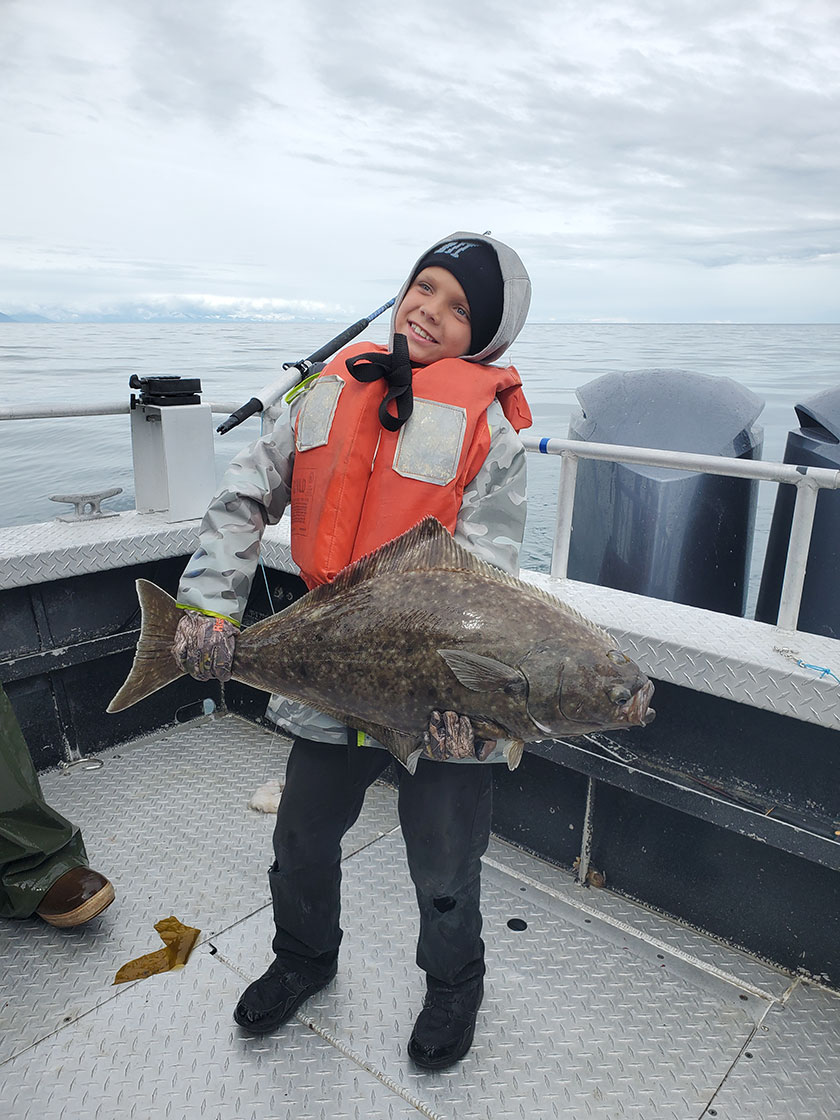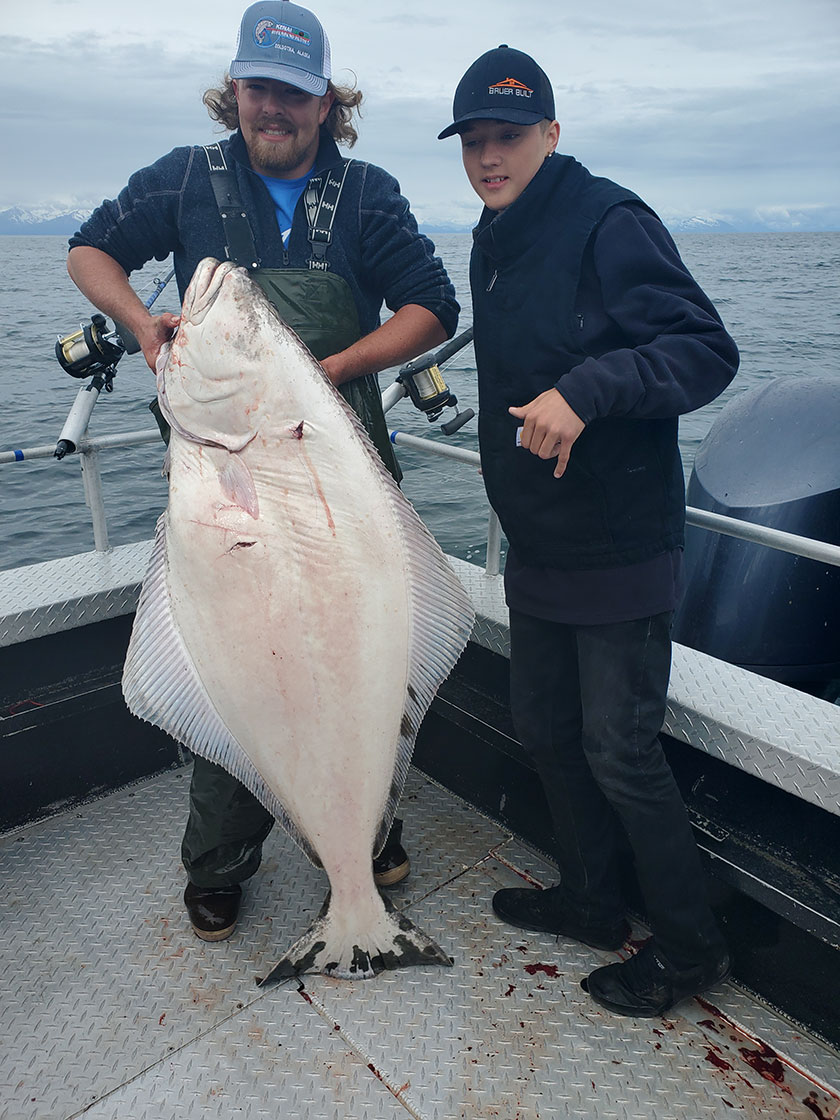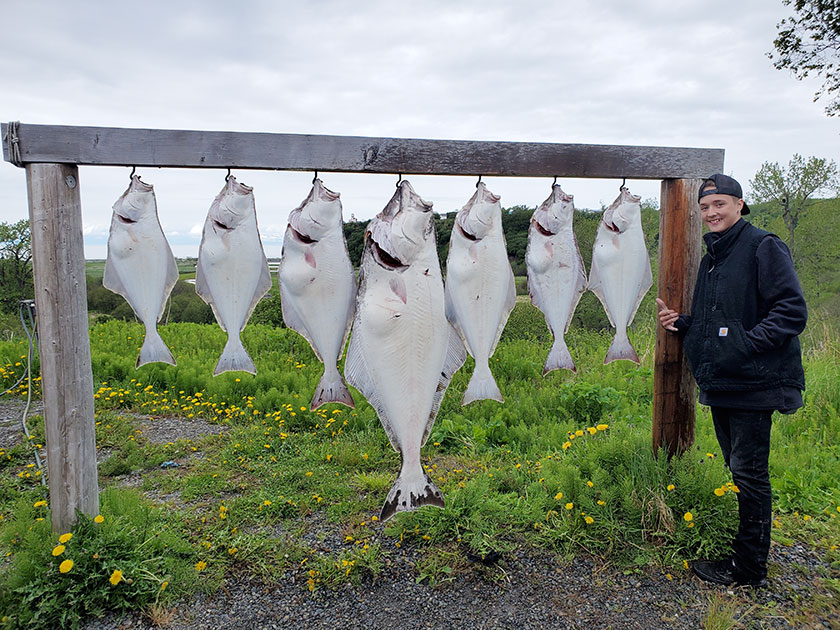Halibut fishing blog & photos by Joe Byers

Our gang peeks through the day’s catch.
Halibut Fishing from the Surf—a Ninilchik Launch Is Truly Unique
The highlight of our one-week Alaskan adventure was to be a halibut charter in Cook Inlet out of Ninilchik. I had spoken with the captain several times on the phone and was optimistic about success. But Alaskan weather intervened as it often does and after rising early and meeting at the boat, the captain said the weather was just too rough to go out. Worse yet, he was totally booked in the days ahead, so we would have to find a new captain.
Since our charter was cancelled, we chose to salmon fish on the Kasilof River where we met some friendly anglers. As luck would have it, they turned out to be a charter captain and his mate who were fishing on their day off. A person who fishes for a living and then goes fishing in his spare time is a real catch.
After we watched Captain Damon Knight land a 20-pound king salmon, we worked out a plan to fish together. Since charter boats are not allowed to fish on Wednesdays, we planned to meet him in Ninilchik at 9:00 a.m. on Thursday.

Captain Knight uses the latest sonar equipment to find promising halibut structure.
Numerous charter boats launch from the Ninilchik area due to its central location on Cook Inlet and quick access to prime fishing grounds. However, the beach has no deep-water port so boats must launch into the surf, a process that takes ingenuity. Each boat arrives at the top of the beach where it is connected to a “water tractor” that has huge tires and enables it to drive into the surf. The tractor connects to the charter boat trailer, with passengers aboard, pulls it to the surf and backs the boat into the water like a standard launch procedure.
This whole process was quite exciting, but we were most pleased with the weather forecast. Temperatures were mild while the winds and the seas were calm. Not exactly a lake, but the swells were barely noticeable as the two 350 HP outboards whisked us toward deep water.
- Young Hunter was the first to land a fish and was delighted.
- Alex holds up the first of the big fish.
- After being harpooned and shot, the big halibut was finally safe to approach.
Halibut Fishing: anchor down, baits in the water
After a 20-minute run, we saw other boats, a sign that fish must be in the area. I had brought some of my special John Beath halibut baits and the mate put them on two rods and his standard rigs on the other three. We used herring for bait and soon had our lines overboard.

Action was fast the full afternoon. Zachary holds up a pair of 32-and-under fish.

Hunter was all smiles with his catch.
Equipment can make a difference in most fisheries, and this is doubly true when halibut fishing. Due to the strong currents of Cook Inlet, each bait was lowered with a five-pound lead weight. Yes, that was a small brick-size chunk of lead that went down 150 feet. When I saw this process in motion, I wondered how in the world we would reel in a fish when the sinker weighed more than most fish back home. The answer was quality rods and reel combos that cost more than $1,000 each.
Sibling rivalry
The night before the charter, the three brothers entered a friendly competition to see who would catch the first fish and who would catch the biggest. All five of our names were listed and then we each wrote our prediction. No money changed hands, but bragging rights were on the table.
I had fished for halibut in Alaska numerous times and normally, these huge fish inhale a bait. One moment you feel a peck and the next minute you hold on for dear life. Not so in this case. “Watch your rod tips carefully,” advised Captain Knight. “When you see it bobbing, get your hand on the reel. If the tip goes down crank like crazy and don’t stop.”
Unlike some charters where anglers take turns reeling in a fish, Captain Knight had a rod and reel for each of us and it was locked into a special holder so it could not get pulled overboard, something I was exceeding grateful for when halibut fishing Ninilchik.
Suddenly, my rod tip began to bounce, and I raced for the rod and began the arduous cranking process. At first, I felt the fish pull, but between the weight of the sinker and the force of the current, reeling line was a challenge. After minutes of steady cranking, I was disappointed to see that all I was reeling in was the five-pound weight.
Then Hunter’s rod tip danced, and he and the mate rushed toward it. The lad cranked as best he could for an 8-year-old but soon tired and mom came to the rescue. This time, after 100 cranks, a 30-inch halibut came to the surface, and we landed our first fish. So, the first leg of the double crown had been settled; Hunter caught the first fish.
We were still celebrating when Bridger’s rod tip animated, and he began to reel. We were halibut fishing Ninilchik with circle hooks and fish were hooked by a consistent reel, rather than a jerk to set the hook. Bridger’s size for a 7th grader enabled him to reel in the fish by himself and suddenly we realized he had hooked a shark. Captain Knight handled the fish and warned us against touching it. Ironically, its teeth were not the issue, but rather, spines that the fish projected from its back as a defense. We snapped a couple of pictures and then the captain pitched the two-foot creature back into the sea.
“Zachary, you have a bite,” yelled the mate. “Hunter, you do too.” Suddenly, mayhem broke out on deck as we reeled in two halibut at the same time. With great skill and care both fish were landed without a tangle. Each was between 30 and 32 inches, exactly the size of fish we sought.
Two fish limit when halibut fishing Ninilchik
Each angler is allowed two halibut. One must be 32 inches or smaller and the other can be of any size. Our goal was to catch five in the “small” range and five of the larger size since halibut grow to hundreds of pounds. A 100-pound fish is considered a trophy, but few are caught on day charters. Captain Knight had only had one on his boat this season and most captains had none.
“I think we need to move,” Captain Knight said as he saw our catches and sized up our options. “There are fish here, but I don’t think we will catch the big ones we are after. Let’s pull up our lines, rebait, and move.”
Modern fishing vessels use high-tech sonar to find good halibut fishing locations and after a 20-minute sprint, the captain showed me a large mound that had lots of bait surrounding it. “That’s where we want to fish, but the trick is to anchor so that our baits will reach that mound.” He explained that Pacific currents often flow in two levels, with upper and a lower current that often flow in different directions. He had to calculate where to anchor so that our lines would drop into the right area.

Launching from the beach, each person boarded before the boat was pushed into the surf.
After several minutes of maneuvering, the anchor was down along with our lines. Alex was the first to hook up and we cheered her on as she wound in another species—a Pacific cod. “I love cod,” she exclaimed and was delighted to add it to our live well.
In the next hour, the bite remained steady, and we landed our fifth “small” and two more in the 40-inch range. Ironically, we only landed about half of the fish we hooked halibut fishing Ninilchik. The strength of the current was constant and if we stopped reeling for just a few seconds, the fish escaped.
One Last Move
Action was nearly constant, yet Captain Knight was still not satisfied with the size of our fish. He said, “I think we should move again,” so we reeled in our baits and unleashed the 700 horses propelling our boat. Along the way, the mate suggested that the cod would make excellent bait, something I experienced on another charter where cut-cod bait created excellent success.
“Honey, I know that the cod is important to you,” I said to my daughter, “but it could make a huge difference in the halibut we catch if we use it for bait.” With the look of disappointment in her eyes, she grudgingly agreed and the slender fish with the giant head was soon carved into bait-size pieces.

Hunter and his big brother smile with the catch of the day.
When the engines slowed and the captain began to scan his sonar for his secret spot, Blake, the mate, baited each hook with the fresh cod and the adventure continued.
Within minutes, rod tips began to bounce but the hookups soon failed. We now fished in 250 feet of water and between the intense current and the heavy weights, we often had to crank the reels in low gear, gathering just a few inches of line with each full turn of the handle. But this is just halibut fishing Ninilchik.
Giant Fish Hook-Up
Suddenly Zachar’s rod tip bent ominously, and the 14-year-old cranked for all his worth. As the rod tip vibrated excessively, Captain Knight warned the mate that this may be a large fish and for the next 10 minutes, the battle raged. Finally, the fish came into view and both captain and mate sprung into high gear. “Get the harpoon and I’ll get my gun,” Captain Knight exclaimed. As Zachary reeled the huge fish within feet of the boat, the mate thrust a harpoon into the beast to prevent its escape. The harpoon tip attached the fish to a stretch of heavy rope and a large buoy, so that fighting the buoy would tire it and allow it to be landed.
- Our catch for the day was the envy of other crews.
- The Sea Venture charters out of Kenai Riverbend Resort in Soldotna.
- Our gang peeks through the day’s catch.
- Captain Knight and his mate made quite a crew and had fun with our boys.
- At the end of the day our crew netted 109 pounds of fillets, a market value greater than the cost of the charter.
- Catching a 100-pound halibut is a lifelong dream of many anglers. Zachary achieved it at 14.
- At the end of the charter Captain Knight and Blake filleted our fish.
- Our gang peeks through the day’s catch.
“Everyone stand back!” cautioned the captain. “And hold your ears,” he commanded as Zachary brought the exhausted halibut near the stern. Bang! Bang! The captain put two .38 slugs into the head of the fish. As Zachary backed away, the captain and mate hoisted the catch onto the boat with a caution to stand clear.
“We call these ankle breakers,” said Blake soberly. “Attached to the five-pound weights, they can whip the sinkers around violently and do serious damage.”
It appeared that the combination of the harpoon and captain’s .38 had killed the fish, which clearly breached the 100-pound mark.
Passengers and crew were jubilant about the catch but how do you take a hold-up picture of a fish weighing more than 100 pounds? Luckily, Blake was a husky guy and gripped the gills as Zachary smiled behind his amazing catch. It was the feather in the cap of halibut fishing Ninilchik that day.
Having reached our party limit of 10 fish, we headed back to the Ninilchik beach where Captain Knight and Blake filleted our fish. Aside from 109 pounds of delicious fillets, we had the halibut fishing trip of a lifetime. Many anglers fish for decades without landing a 100-pound halibut, yet Zachary achieved this mark at 14. The day was everything we had hoped and there was little doubt about next summer’s vacation.
Joe Byers
Author’s Note: Captain Damon Knight fishes with Kenai Riverbend Resort [site] in Soldotna, Alaska. Contact him by phone at (907) 740-1234. You might also find him fishing on his day off.











